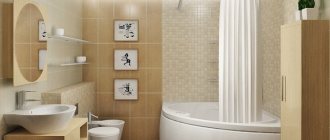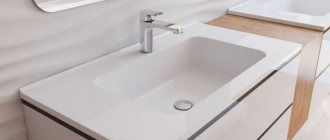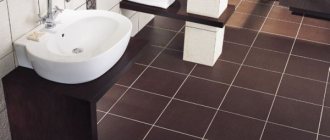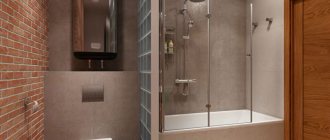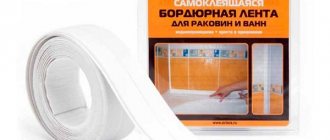| Place | Name | Characteristics in the rating |
| Top 10 Best Bathroom Heaters |
| 1 | REDMOND SkyHeat 7002S | Convenient control via smartphone |
| 2 | Ballu BEC/EZER-2000 | Effective combination of price and quality |
| 3 | Heliosa EH110/FM | The best efficiency of the device |
| 4 | Polaris PCH 1096 | Best selling model |
| 5 | Comfort “Umnitsa” TKV-2000 W | Minimum weight |
| 6 | Hintek IW-07 | Excellent splash protection |
| 7 | Veito Blade | Modern technologies, new materials |
| 8 | AEG WKL 753 S | Model with automatic climate control |
| 9 | Timberk TCH AR7 1000 | Best cost IR heater |
| 10 | Tesy CN 03 050 MIS F | Mini convector for small bathrooms |
Many of us are accustomed to the fact that bathrooms are heated using heated towel rails or central heating radiators. However, sometimes other types of devices are installed as an alternative or additional means. They have a completely different principle of operation, and therefore differ in design and technological solutions. Such equipment is characterized by compact dimensions, the ability to withstand temperature changes, high humidity, and become a harmonious element of the interior.
When choosing the ideal heater for a particular case, you should consider:
- ratio of room area and model power;
- how quickly the device heats up/cools down;
- the material from which the device is made. It must have anti-corrosion properties, good thermal conductivity, and be safe;
- placement method (wall-mounted, floor-mounted, etc.);
- efficiency of work;
- availability of additional features (thermostat, zone heating of the bathroom, shutdown when overheating, etc.);
- product design.
The most popular models of the most common types are collected in our rating. They are well represented in retail chains, are in demand and have received high ratings from buyers.
Modifications of wall heaters for the bathroom
Today, a heated floor is often used to heat a bathroom. The solution is reasonable, but where to dry the robes and towels? Not on the floor. Heated towel rails and electric heaters will help solve the dilemma. The devices combine perfectly with a heated floor system - the towels dry quickly and your feet are always warm.
Water heated towel rails
This invention is not new. Every Soviet bathroom had a coil with paint peeling off from dampness. All sorts of small things like socks and handkerchiefs were dried on it. Today, the bent pipe has been replaced by an elegant chrome-plated device that performs the same functions. Such a device is powered from a hot water supply or heating system.
The coil must be made of stainless steel, because... a steel tube in a humid environment will quickly become unusable. A heated towel rail made of copper and brass can be connected to an autonomous heating system.
Electric heated towel rails
If the house does not have hot water supply and water heating, an electric heater is installed in the bathroom. It is connected to a 220 volt alternating current network and operates on the principle of an oil radiator. A coolant circulates through the tubes of the device, heated by the heating element. A standard electric battery for a bathroom is made in the form of a coil or ladder.
Electric heated towel rail in the form of a coil
Modern models consume no more energy than incandescent lamps. For convenience, the device is equipped with a timer and thermostat, with which you can set the operating schedule and temperature range.
Finally. When choosing a radiator for a bathroom, you don’t need to look at the design - the radiator can be covered with a decorative screen if necessary. Practicality, reliability, and heater power should come first. Savings are also inappropriate here. An expensive, high-quality device installed by a specialist will work for many years and will recoup its cost many times over.
Main types of heating devices for the bathroom
Everyone knows that the bathroom is a room with a high level of humidity. Therefore, it is necessary to choose a heating device that will function flawlessly in such conditions. For this purpose, you should study in detail the main technical characteristics of different heating devices:
- Cast iron batteries are quite bulky, so they do not have a very attractive appearance. But this factor loses significance, since batteries are characterized by good heat dissipation, long service life and reasonable price. The best option is heating devices made of cast iron with a protective powder coating. It contains particles of polymers and ceramics, thanks to which the surface is covered with a very durable, uniform layer.
- Steel heating appliances can be called not a very good option. The fact is that a humid environment promotes the formation of rust spots, and iron materials lend themselves to this much more easily than others. In addition, the affected areas leak, and during seasonal pressure testing, water flowing under pressure can penetrate weak spots in the radiator.
- Aluminum radiators for the bathroom are considered an ideal option in a house with autonomous heating, as they are lightweight and compact. In addition, it should be taken into account that the central heating system requires the installation of reinforced models due to poor-quality coolant and strong water hammer. It is also worth understanding that connecting to a pipeline made of another metal accelerates the corrosion of aluminum.
- Bimetallic batteries for the bathroom are steel products wrapped in an aluminum jacket. Such a heating device has a service life of about 20 years thanks to special manufacturing technology taking into account all the features of the domestic heating system.
When choosing heating radiators for the bathroom, it is recommended to give preference to devices that can heat the room, dry clothes and at the same time fit perfectly into the overall interior.
Advantages of contacting the company Warmth and comfort
- Experience of specialists in the field of installing batteries in the bathroom. Our professionals are ready to perform installation in an apartment, country house, or other facility.
- Individual approach. When improving heating systems, specialists always take into account the wishes of the customer. Just let us know in advance which batteries you want to use and how to install them.
- Efficiency in solving problems. The installation of radiators will be completed as soon as possible. In the near future you will be able to start using your heating system with new high-quality batteries.
- Availability of professional equipment. We have everything necessary for installation work.
- Accurate execution of work. Installation of heating radiators is carried out not only quickly, but also very carefully. Certified welders and other qualified personnel comply with all established requirements.
- Consulting support. You can always ask our specialists any questions about batteries, pipes, fittings. Managers will tell you about all the main models and components.
Contact us! We will help make your bathroom warm, cozy and comfortable! With modern, stylish batteries it will look as attractive as possible.
The bathroom should be warm - this is an axiom
In this small but extremely important room for any family, children are bathed, washed, and clothes are washed and dried. To create a comfortable microclimate in the bathroom, you need a source of dry heat
A radiator in the bathroom will not only warm you up and help dry your laundry, but will also help prevent the appearance of mold and unpleasant odors. In this case, it is desirable that the functionality of the device be combined with its aesthetic appearance.
What kind of pipes will we connect?
If for a private house, where the coolant temperature rarely exceeds 70-80℃, the use of polypropylene pipes is still acceptable, then in apartments not everything is so simple. In most cases, SNiP prohibits the use of not only polypropylene products, but also metal-plastic and cross-linked polyethylene in central heating systems. In emergency situations, the temperature of the network water can reach 120℃; a polypropylene pipe in such conditions will last for a couple of hours.
Even during normal operation, the temperature of the coolant in the central heating lines can be increased to 105℃ for a short time. The same propylene, when operated above 70℃, begins to rapidly lose its properties. We can talk about this topic for a long time, so based on the experience of using various pipes in apartment buildings, let’s summarize the results:
- In houses where there are no individual heating points, pipes made of steel, copper or stainless steel must be used to install heating radiators.
- In high-rise buildings with their own low-temperature heating system, it is possible to use any type of pipeline - polypropylene, metal-plastic, steel, copper and cross-linked polyethylene.
Important! Be that as it may, in central heating conditions, where safety requirements are high, you need to use pipes from trusted manufacturers with a long operating history. Beware of new product models that do not yet have a baggage of positive reviews.
Universal insertion method
The coil operates on the principle of a gravity pump. If you insert it correctly, natural circulation and proper operation of the radiator are guaranteed. It is necessary to develop an installation diagram, strictly following the model instructions, and also taking into account the location of the riser in the bathroom.
For most models, the best option for tapping is to supply the coolant through the upper outlets (and the outlet is made from below). This is achieved using universal connections for the battery in the bathroom (photos of examples of work are in our article). This type of insert has a number of advantages:
- the direction and speed of water supply in the riser do not in any way affect the performance of the battery;
- there is no need to bleed air after circulation is turned off.
Another important advantage is the independence of the installation from the location of the riser.
Connection
Water heater
How to properly connect a water heated towel rail or radiator?
- A bypass is required before the dryer or radiator. It will ensure the passage of the riser or liner when the heater is turned off (for example, in the summer heat);
- To shut off the dryer, it is better to install ball valves rather than screw or plug valves. They do not require maintenance, always hold water tightly and have a huge resource;
- It is better to connect both the dryer and the radiator not with spurs, but with American ones. In this case, installing and dismantling the heated towel rail (for example, to lay tiles underneath) will take no more than a couple of minutes.
Electric heater
Heated towel rails, with their ridiculous power, can be connected to any outlet, regardless of grounding or wire size. But for full-fledged heaters, the instructions are somewhat more complicated:
- The outlet must be connected to ground and have appropriate terminals. The bathroom is a damp room, and a phase short circuit to the housing can lead to the most unpleasant consequences;
- The socket must have a cover that protects it from splashing water;
Wiring is calculated based on 1 mm2 copper wire cross-section for 8 amperes peak current. Let me remind you: current is equal to the result of dividing the power in watts by the supply voltage in volts. So, for a 2 kW device you need a copper wire of at least 2000/220/8 = 1.36 mm2.
What if you remove the radiator from the bathroom?
There is a category of citizens for whom not only the radiator in the bathroom, but even the heated towel rail is in the way and they decide to eliminate them. Immediately there is more space, neat and minimalistic, in a word – fashionable. But you can get the following results:
- temperature decrease below a comfortable level;
- increased humidity - as a result, the appearance of fungus;
- imbalance of the heating or hot water system.
This means that it is impossible to change the battery in the bathroom without employees of the service organization. They install the heat exchanger taking into account the design data of its hydraulic resistance. This is necessary for the system to be balanced. It is prohibited to even move the radiator to another place, much less completely dismantle it. We strongly do not recommend removing heating appliances from the bathroom.
How to hide a battery in the bathroom
How to make a radiator less noticeable? There are four ways to disguise radiators in the bathroom:
- Construction of a plasterboard box. To do this, you need to use moisture-resistant plasterboard sheets, because ordinary ones will not cope with extreme temperature conditions. The structure is constructed in the simplest way: a box is made from profiles, sheets cut to shape are placed on it. You need to make several holes in the top sheet so that warm air can escape into the room.
- Decor using tiles. This method is similar to the previous one, but differs in an increased level of energy consumption.
- Disguise behind plastic panels. This method is the simplest and relatively cheap. The low level of fire resistance is the main disadvantage of this method.
- Disguise with blinds. This method is suitable for those who value the usable space of the bathroom. Blinds allow you to have constant access to communications.
In addition to these four methods, there is also a radical one - installing the battery directly into the bathroom wall. However, due to the complexity and impossibility of servicing during an unusual situation, it is better not to tempt fate and not to commit rash acts.
Nowadays this is becoming less and less common, but some still have a cast-iron radiator in the bathroom, which was installed under the Soviets. It is clear that during repairs it is replaced with a heated towel rail, the thermal power of which is usually sufficient. In an apartment, the bathroom is small, but in cottages, for example, bathrooms are made large, so just a towel is not enough to heat it. You need to install an additional battery.
When is it profitable to install underfloor heating?
| Advantages and disadvantages of using heated floors | |
| Flaws | Advantages |
| Installing underfloor heating can be challenging and requires proper preparation | Heated floors have a favorable distribution of heat generated. Thanks to this, it is warmest at the feet, a little cooler in the upper areas of the room |
| The system is best assembled before laying the floor | We can better regulate the temperature we need. It is also possible to use so-called low-temperature heating so as not to overheat the bathroom. |
| Underfloor heating is characterized by high heat inertia. Thus, the elements will take longer to heat up and the heat will pass through the concrete layer. The same applies to cooling - it also lasts a long time. | The whole room is heated evenly |
| If the system is already installed, it cannot be changed or improved | The underfloor heating system is invisible. It does not take up space and does not distort its aesthetics |
| This heating is “clean”. And does not lead to the diffusion of various impurities in the bathroom | |
| Floor heating is very economical - all thanks to obtaining a constant, optimal temperature | |
| This system can be adjusted automatically | |
It should be remembered that heated floors are divided into two types, which differ mainly in their mode of operation:
- Electric heated floor . The operation of the system is based on a special mat (mat), which is equipped with a heating cable. It is controlled by a regulator, and the mat itself is characterized by fast action and low thickness, which makes installation and laying of the floor easier. Considering the area of underfloor heating, this solution is cheaper to purchase and install, but can be associated with significant operating costs. This is because the system runs on electricity;
- Heated water floor - the solution is initially more expensive and more difficult to install. It consists of a pipe system that can raise the floor level. Despite all this, this is a more economical type of heating.
Sale of land on the Cape near the Volga 88 acres, 165 km from the Moscow Ring Road VIEW
Step-by-step installation of a battery in the bathroom
The first step is to prepare materials and tools. The tool is selected depending on the type of water supply pipes in the room. If installation is carried out through PP pipes, then it is necessary to ensure the availability of ball valves, mounting brackets, polypropylene pipes, a soldering iron and a knife for PP pipes.
The next step is dismantling the old equipment. Here you will need to do some preparatory work - if necessary, agree with the house management company on the possibility of disconnecting the riser from the water. Well, then - depending on the situation. If the coil is welded to the riser, you just need to cut it off with a grinder; if it is screwed on, unscrew it and dismantle it.
Step three. We install bypass and ball valves. Of course, the battery mount can be installed without a bypass, but following the recommendations of experts, it is better to install it. Ball valves must be installed at the ends of the dryer. This will allow you to shut off the water without turning off the riser.
The final step is installing the dryer coil. The process here is the same as with nailing a shelf to the wall. The only condition is to align the coil vertically and maintain the permissible distance from the wall.
Bathroom air conditioner
Appliances and the bathroom are not nonsense. Everyone is afraid of closures. This often prevents a person from dreaming of an air conditioner, for example. And the bathroom will only suffer. The stereotype should be changed, find out from specialists what is the norm when installing and connecting an air conditioner in a room such as a bathroom.
Having learned that there is a norm and standard for the electrical network, ventilation, and appliances, you can objectively assess the situation, make a wise decision, and create your own reality. It is logical to make housing comfortable and safe, but often a person, out of habit, is content with the most necessary, basic things.
How rational is it to install an air conditioner? Is the bathroom big enough for this? It all depends on the dimensions, on the parameters of the equipment, on the characteristics of the ventilation pipe. It's definitely worth trying to do this too. The heating will be perfect.
Arguments and counter-arguments
Behind
- According to current SNiP, the temperature in the bathroom must be maintained at least +25C all year round. In the cold season, it is quite difficult to provide it without its own heat source in the room;
- In the limited space of a city apartment, the bathroom is often used for drying clothes. Where do you think it will dry faster - in a cold room or in a warm one?
The causes of fungus are cold and dampness.
Against
- In a cramped bathroom space, a radiator heated to 70 - 90 degrees often causes burns;
- In the summer heat, heating an already stuffy room becomes inappropriate.
Which battery to choose
When choosing a heating battery for a bathroom, you should take into account the fact that not every one of them can operate reliably and for a long time in conditions of high humidity.
To choose the right radiator, you need to take into account all the features of its operation.
Let's consider the main advantages of modern batteries.
Cast iron. Such products often look quite bulky, but are characterized by optimal heat dissipation and a long service life.
When choosing a battery, pay attention to the presence of a special protective coating (powder coating). Models with it are maximally resistant to corrosion and constant exposure not only to moisture, but also to steam, temperature changes, and aggressive detergents. Steel
Such products are not suitable for use in the bathroom. This is due to the fact that steel models rust quickly. The only exceptions are modern models made of steel with anti-corrosion coating. But often such radiators are quite expensive. Aluminum. Such models are compact and lightweight. They are ideal for bathrooms in private houses and cottages. Autonomous heating systems are not subject to hydraulic shocks. Thanks to this, you don’t have to worry about the battery simply breaking during one of them. Bimetallic. Such radiators in the bathroom can last up to 15-20 years. Bimetallic models cope excellently with all their functions. Original products also decorate the interior of the bathroom. They can be used as heated towel rails, robe hangers, mirror stands, etc.
| Description of service | Unit | Price |
| Manual arc welding of ferrous metals for | 1cm. seam | from 50 rub. |
| Pipe welding | 1 joint | from 200 rub. |
| Plumbing work | ||
| Replacing a heating radiator - batteries (2 pcs. or more) | 1 PC | 4000 rub. |
| Installation of a heated towel rail | 1 PC | from 1500 rub. |
| Insertion into the water supply/heating riser | PC. up to d50 | from 500 rub. |
| Installation of a jumper (bypass) for a heated towel rail | 1 PC | 6000 rub. |
| Filter and counter installation | PC. | 700 rub. |
| Replacing sewer pipes throughout the apartment | 1 point | from 500 rub. |
| Installation of supply pipes to the heated towel rail | 1 PC. | from 1500 rub. |
| Piping throughout the apartment is polypropylene | 1 PC. (hot water/hot water point) | from 2000 rub. |
| Replacing a hot/cold water riser with water access to an apartment (floor) | floor | 4500 rub. |
| Relocation of cold/hot water/heating riser (piece floor) | pcs. floor | 4000 rub. |
| Replacing the heating riser | floor | 3500 rub. |
| Replacing taps | PC | 500 rub. |
| Manufacturing of metal structures (cost of finished product) | ||
| Welded fencing (grids, gates) | p.m. | from 500 rub. |
| Fence (welded, chain-link mesh) | p.m. | from 1000 rub. |
| Trade and warehouse equipment (racks, shelving, furniture) | p.m. | from 1500 rub. |
| Metal structures and metal products according to customer drawings | ton | from 15,000 rub. |
| Piece products | negotiable | |
| Additional services | ||
| Painting work, surface priming | p.m. | from 50 rub. |
| Metal delivery in Moscow and the region | from 1500 rub. | |
| Cutting metal in one go | from 10 rub. | |
| Welding and installation work | negotiable |
Types of heating devices for bathrooms
Many types of heating devices are used to heat bathrooms and baths. Suitability criterion is compliance with the above requirements and the interior of the premises. Let's look at a few of the most popular heaters.
Electric heated towel rails
These compact devices are autonomous, as they do not depend on water and heat supply systems. The heater consists of a decorative tubular coil in which a heating element is placed, which converts electricity from the household network into heat.
Two types of heated towel rails are produced:
- liquid - a heating element is installed in a sealed tubular housing filled with oil or antifreeze;
- dry (cable) – the heating element in the tube is a self-regulating heating cable.
Installation of these heaters is simple and does not require professional skills - the unit is installed on the wall using standard fasteners included with the device.
Despite their external similarity, these two types of heated towel rail differ in technical characteristics, knowledge of which will facilitate the choice when purchasing a unit.
Liquid heated towel rails
According to the principle of operation and design, this type of heater does not differ from an oil heater - a heating element installed in a sealed housing with oil. The presence of oil, the amount of which must ensure convection of the liquid in the housing, and a more complex safety system, determines the larger dimensions and weight of the liquid unit than that of cable devices. In addition, in order to ensure the tightness of the radiator, the design of the liquid heater is static, that is, it does not contain rotating elements that increase the ease of use of the device when drying things.
Liquid heated towel rails are produced with a power of 0.3 to 0.6 kW, which, if the safety system is working correctly, is enough to heat the surface of the heater to a temperature of 70 degrees - safe for short-term contact with the body and providing a comfortable environment in the room.
Important! Liquid heaters can be connected to the network through a moisture-proof socket or in a hidden way, but they must be grounded - the third grounding conductor in the power cable.
Cable heated towel rails
Since the heating element in such devices is a self-regulating electric cable, the requirements for the tightness of the tubular body are not as high as for an oil unit - the body of the cable device must provide protection of the cable only from mechanical damage and moisture, therefore, for convenience, the design of such units includes movable ( rotating) elements.
Cable heaters, which are significantly smaller in weight and dimensions than liquid units, are produced in various configurations, which allows you to choose a device for a specific installation location.
The power of such units, depending on the model, is 60-120 W, which results in low energy consumption. The device heats up quickly and cools down just as quickly, which is not a disadvantage, but a feature of this heater, which is also easy to install and safe to use - there is no need for a grounding device, and the temperature of the body surface does not rise above 65 degrees. The heater is also connected to the network through a socket or in a hidden way.
Heat fan
A fan heater is one of the simplest heating devices, the power of which is in the range of 2-2.5 kW, available in the entire price range and suitable for use in bathrooms.
The unit is a housing in which a blower is installed - a fan that drives room air through electric heating elements. A heater of a higher class can be equipped with a thermostat and a temperature sensor, which control the device’s on/off switching to maintain the desired temperature in the room.
Depending on the location of installation, devices are divided into floor, wall and ceiling.
Floor-standing devices are compact and lightweight, have less power, can be moved to any convenient place and directed in the desired direction.
Wall-mounted fan heaters are more powerful electric heaters that have a stationary installation location, but their movable deflectors allow you to change the direction of the flow of warm air in the vertical plane.
Ceiling-mounted heat fans are the most convenient because, in addition to heating the room, they prevent condensation from forming on the ceiling. The sufficiently high power of such devices determines their use in spacious baths and showers, as well as relaxation rooms and dressing rooms of saunas.
Important! For bathrooms, wall-mounted or ceiling-mounted fan heaters are preferred, as floor-mounted ones impede foot traffic and are more susceptible to unwanted direct contact with water.
The heating element in fan heaters can be ceramic, spiral or tubular (TEN).
The most advanced and efficient devices are heat fans with ceramic heaters.
These devices use posistors - semiconductor elements in a ceramic shell, shaped like plates - as converters of electricity into heat. To increase the heat transfer area, the heaters are decorated with a honeycomb heat exchange grid made of aluminum.
The temperature of semiconductor elements does not exceed 150 degrees, which increases the safety of their operation. In addition, posistors have the property of self-regulation - the ability to increase resistance with increasing temperature until conductivity is completely blocked. Thus, as the air in the room heats up, the electricity consumption of such a heater will gradually decrease, which saves not only electricity, but also the automation system.
Naturally, the cost of fan heaters with ceramic heating elements is much higher than heaters with other types of heaters.
Devices with an open heating coil are less preferable when choosing a bathroom heater for the following reasons:
- Accidental contact of a person with a hot spiral is fraught with burns and electrical injury;
- there is a danger of small objects igniting when they come into contact with a hot coil;
- the spiral thread, which heats up to almost 1000 degrees, is in open contact with air and is therefore short-lived;
- prolonged operation of a spiral fan heater worsens the microclimate in the room;
- combustion of dust falling on a hot coil is accompanied by an unpleasant odor.
But the low cost of spiral fan heaters and the ability to carry out repairs on their own contribute to the demand for these devices.
Tubular fan heaters are long-lasting, high-power devices (3-3.5 kW), using the same coil for heating, but placed in a steel tube, smooth or ribbed, filled with quartz sand or manganese oxide - heating element.
In domestic premises, including bathrooms, such powerful heaters are used extremely rarely.
Electric convector
This heating device is a closed electric heating element (TEH), installed in a housing with a control system, converting electricity into heat and releasing it to the surrounding air. Heated air rises, giving way to cold air and thereby causing the circulation of convective flows - convection.
In fact, all heating devices that, during operation, transfer heat from their surface to the surrounding air are called convectors - these are water and steam heating radiators, oil heaters, solid and liquid fuel stoves, gas convectors, etc. But in everyday life, only electric heaters with heating elements are called convectors.
For spacious bathrooms and sauna dressing rooms, the best choice from this group of heaters are wall heaters - stationary devices of small thickness, but with a large heat exchange area, protected from tipping over by a rigid attachment to the base.
In small bathrooms you can use portable floor-mounted convectors of low power
The maximum power of convector electric heaters produced for domestic conditions is in the range from 0.5 to 2 kW, which makes it possible to provide comfortable conditions in a bathroom of any size using one or more such devices.
The popularity of using electric convectors in bathrooms is due to the following advantages:
- safety – case temperature no higher than 65 degrees;
- waterproof design;
- ease of installation and daily maintenance;
- possibility of automatic control;
- quiet operation;
- quick access to operating power;
- insignificant negative impact on the microclimate.
The disadvantages of these heaters, like all heaters with heating elements based on a spiral, include high energy consumption - economical posistors are not used in such devices (without a fan) due to the relatively low heat transfer temperature.
The cost range of electric convectors cannot be considered widely accessible - the price of such a device depends on the power, degree of automation equipment and design, while of two devices with the same characteristics, a product from a more well-known manufacturer will be more expensive.
Infrared heaters
Infrared radiation is waves invisible to the human eye, located in the spectrum after red rays. These rays affect the surface of the objects they reach - they excite the movement of molecules to a certain depth, which means they increase the temperature of the physical body, but do not heat the transit medium (air) during passage. Objects heated by infrared rays give off heat to the air and thus increase the temperature in the room.
Heating devices whose operation is based on infrared radiation are called IR heaters.
Depending on the installation site, infrared heaters are produced as floor-mounted, wall-mounted or ceiling-mounted.
Infrared heaters for baths are more convenient in wall and ceiling versions, but it is possible to use floor-mounted IR devices - compact models with a vertical reflector arrangement.
For a bathroom with high ceilings, infrared ceiling-mounted heaters are especially good - such devices are not noticeable even if they are large in size, and their effectiveness does not depend on the distance to the device.
When advertising infrared sauna heaters, manufacturers present these devices as an independent type of heater capable of providing the required temperature conditions. Actually this is not true. The high temperature in the sauna is maintained by other heating equipment, and IR heaters are used in the dressing room and relaxation room in the Finnish bath. In the sauna itself, these devices can only be used when repairing a bathhouse in winter - to ensure technological temperature conditions.
A convenient type of IR heaters for bathrooms are panel electric convectors - moisture-resistant devices of a high class of aesthetics. IR panels are made both colored (plain or imitating natural stone) and combined with mirrors, which hide the true heating function of this element on the wall. The decorative nature of panel infrared heaters for the bathroom determines their high price relative to other IR heaters.
For the bathroom, modern infrared heaters have ceased to be something exotic - the range of varieties produced is so wide, most of which are offered at very reasonable prices.
How to choose a battery for the bathroom
It is extremely difficult to remove the fungus.
There is no dispute about tastes, so everyone chooses the design of a heated towel rail or radiator for the bathroom for themselves
The first important decision is what the heat output of the heating device should be. If according to the rules, then you need to calculate heat loss
You need to be able to do this, as there are a lot of nuances. It is unlikely that you will be able to make a competent calculation at a glance. To get an accurate value, you need to contact professionals.
The popular method is to select a battery for the bathroom according to the area of the room. Yes, the resulting value will be approximate, but the calculation is not complicated, and most importantly, it works. For every meter you need 100 W of thermal energy (ceilings 2.5 m).
Having found out the required power, decide on the type of heating device:
Naturally, water heating registers include heating registers (battery and water towel). Their advantage is that there are no operating costs. The same cannot be said about electric heated towel rails, but they also have their strengths. This is work all year round without interruptions, a varied design, the ability to control the device remotely via smart sockets
Pay attention to the connections for connecting water towels to the circuit. They can be located on the side or bottom
The distance between them must coincide with the pipes on the risers.
How to adapt a fireplace for heating a dacha is written here.
Determining the power of heating equipment
In order not to make a mistake with the purchased device, first of all you will need to decide on its power. Since the ability of the equipment to heat a room of the required area depends on it.
Before you buy a heater for your bathroom , it’s a good idea to measure the room. And in the store make your choice based on these indicators:
- 500 W will be required to heat about 5-6 sq.m.
- 700-800 W – for 7-9 sq.m.
- 900-1100 W – 11 sq.m.
- 1250 W – 12-14 sq.m.
- 1500 W can heat a room of 16 sq.m.
- 1750 W – 18-19 sq.m.
- 2000 W will heat 20-23 sq.m.
- 2500 W will heat a room of 24-27 sq.m.
Heating appliances in the bathroom
The heated towel rail performs the function of heating the bathroom.
There is no doubt that a battery is needed in the bathroom, but why is it there? We are talking about an ordinary radiator that is in every room. In the bathroom, the heated towel rail is mainly used as a heating device. This is, in fact, a water heating register, whose main function is heating. This means that he is also a kind of battery.
The bathroom is small, so a towel is usually enough. In large bathrooms, the power of a heated towel rail will not be enough; in this case, it is necessary to install a battery in the bathroom. Suitable for this:
The latter are the most practical and reliable. But it also happens that you inherited a cast-iron radiator in the bathroom along with the apartment. Previously, they weren’t particularly worried about making it beautiful. The main thing is quality and durability, so we installed ordinary cast iron radiators in three sections in the bathroom. Usually they are replaced with either a water heated towel rail or a combined unit (battery + heated towel rail). Here you need to look at the heat loss of the room.
Read more about the heating device in the country in this article.
General installation requirements
Installation of a water-based battery is carried out in compliance with the basic requirements:
- The diameter of the dryer tubes should be equal to the diameter of the riser - no narrowing or expansion.
- It is necessary to install a jumper between the heated towel rail outlets.
- Shut-off valves must not be installed on the lintel. This also applies to the section of the pipeline up to the bypass.
- The dryer must be installed at a height of at least 120 centimeters from the floor.
- The distance between the wall and a heated towel rail with a tube diameter of up to 2.5 centimeters should be 3-4 centimeters. With a diameter of more than 2.5 - 6-7 centimeters.
